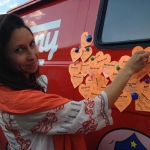
Matt D'Arrigo
I write this as an arts leader but, more importantly, I also write this as a dad. My wife and I have two amazing children, ages 5 and 8, who are lucky to have both parents who are artists and work in the arts. They receive daily
artistic and creative encouragement at home. We want our children to be creative in their approach to everything in life, to learn and grow with a sense of wonderment, curiosity, and discovery. We want them to express themselves in authentic ways and to respect and understand the immense role the arts and humanities play in shaping all of our lives to be more meaningful, fulfilling, and enjoyable.
They attend a fantastic public school, one of the best in San Diego (I know, I’m biased). They receive arts programming once a week, but only through the generosity of parents and families donating to a foundation that pays for it and volunteers who help support in the classroom. We’re lucky they attend a school in a more “well off” area of town whose families have the means to fund the arts programs. If they attended a lower income school, and we didn’t hold the arts as a highest priority in our home, they would receive very little to no arts exposure or engagement. I don’t think that’s fair.
Read More










 Matt D'Arrigo
Matt D'Arrigo





